Le Tartare de Tortore
par Darya
En rentrant du marché ce matin, nous nous sommes arrêtés chez le boucher. Il y a toujours un monde fou chez lui, mais notre patience est toujours récompensée tant ses produits sont extraordinaires. La semaine passée j’ai improvisé un tartare de bœuf au couteau qui s’est avéré si bon que j’ai eu envie de réitérer l’expérience pour la partager avec vous sans attendre. Je me méfie toujours des tartares servis dans les restaurants, demandant systématiquement si la viande est hachée au couteau, et si tel n’est pas le cas, prenant autre chose. Les pseudo-tartares à base de viande hachée Dieu-sait-quand, à partir de Dieu-sait-quel-animal venu Dieu-sait-d’où, et qui ont encore la forme de la barquette de polystyrène dans laquelle ils ont été livrés, sans façons ! Autant vous dire que je ne mange donc presque jamais de tartare au restaurant. La fraîcheur de la viande est la condition sine qua non d’un tartare réussi ; elle doit être fraîche et fondante avant même d’être assaisonnée, et j’aime en goûter un morceau avant d’y ajouter quoi que ce soit. Heureusement, avec notre boucher, nous pouvons manger du tartare les yeux fermés.
J’aime le tartare « traditionnel », avec son accompagnement de cornichons, câpres, échalotes, herbes, jaune d’œuf cru et divers condiments, dont vous trouverez une illustration superbe ici. Je le préparerai un jour où le Grand sera absent. Mais pour lui, j’ai créé un tartare de composition plus acceptable, avec un assaisonnement d’inspiration italienne. Et ça a marché ! Non seulement il s’est réconcilié avec l’idée de manger de la viande crue, mais il a vraiment aimé le mélange des ingrédients, qu’il n’a cessé de complimenter (et je l’ai laissé faire). Résumons : une viande de qualité et de fraîcheur irréprochable, un assaisonnement de caractère, une salade verte en accompagnement (quelques pommes de terre sont autorisées en hiver), et tout le monde est heureux !
Ingrédients (pour 2)
– 350 gr. de filet de bœuf
– 1 c. à soupe de pignons de pin
– 6 tranches de tomates séchées à l’huile, égouttées
– 2 petites poignées de persil plat (ou plus, si vous le souhaitez)
– 1 grosse gousse d’ail, épluchée et dégermée (j’ai utilisé deux petites gousses ici)
– Environ 20 à 30 grammes de parmesan
– 1½ c. à soupe d’huile d’olive
– 1/8 c. à soupe de flocons de piment (d’Espelette)
– Du sel, du poivre noir
Recette
– J’ai demandé à mon boucher de hacher le bœuf au couteau et il s’est fait un plaisir de le faire, mais si votre viande n’est pas déjà hachée, je me permets ici de citer la recette d’Anne mentionnée ci-dessus : « Hacher au couteau le filet de bœuf : couper d’abord des lanières, les superposer et découper en petits carrés. C’est fastidieux mais meilleur, plus les carrés sont petits, meilleur c’est ! » [fin de la citation]
– Assaisonner le bœuf de sel, de poivre fraîchement moulu et de piment (d’Espelette), mélanger.
– Placer les pignons de pin dans une petite poêle. Faire chauffer la poêle à feu moyen et faire dorer légèrement les pignons en mélangeant de temps en temps et surtout en surveillant bien, car il suffit de les oublier une minute de trop pour qu’ils brûlent ! (Croyez-moi, je suis passée par là plus d’une fois, et ce n’est PAS drôle !)
– Hacher les tomates séchées, l’ail, le persil et les pignons. Il ne faut pas que les morceaux soient trop finement hachés, cela donnera plus de texture et de saveur au tartare. Couper le parmesan en petits dés ou en lamelles (à l’aide d’un économe) ; personnellement, je préfère les petits dés, encore une fois pour la texture et la saveur du tartare ; les lamelles se fondent un peu trop dans le tartare et c’est dommage.
– Ajouter tous les ingrédients hachés à la viande. Ajouter 1½ c. à soupe d’huile d’olive et bien mélanger. Goûter et rectifier l’assaisonnement en sel et poivre (à ce stade j’ajoute un peu de fleur de sel s’il y a besoin de saler un peu plus). Laisser le tartare reposer le temps de laver et essorer la salade, et de préparer l’assaisonnement de celle-ci.
– Une idée pour servir : poser un emporte-pièce de 8 cm de diamètre sur l’assiette. Mettre le tartare au milieu en tassant bien. Ôter l’emporte-pièce, servir la salade à côté et dévorer.
The English-speaking corner
Tortore’s Tartare
There is always a long line at the butcher’s, and we just have to accept it, and stand, and wait for our turn. But our patience is always rewarded; he is The Best after all! Last week, I improvised a Tartare de bœuf au couteau (which could translate as « hand-chopped beef Tartare ») which turned out so well that I couldn’t wait to make it again and share the recipe with you! I am always very suspicious of the Tartares served in restaurants, and always ask whether they are hand-chopped, and if the answer is « No », I chose something else (and tend to avoid going back to that restaurant). Pseudo-Tartares which are ground God-knows-when, come from God-knows-where and from God-knows-what-animal, and served straight out of square Styrofoam molds are not for me! As a result… I hardly ever eat Steak Tartare at the restaurant. The freshness of the meat is the only possible way you can get a tasty Tartare; the meat should melt in the mouth before even being seasoned, and I always try a little piece before starting to season the meat. Fortunately, we can blindly trust our butcher in that respect!
I do like the « traditional » Tartare, with its seasoning of Cornichons, capers, shallots, herbs, raw yolk, and condiments, of which Anne gives a superb version here (in French). I will make it some day, when Pierre is away. But for him, I came up with a more acceptable version, using an Italian-inspired seasoning. And he loved it! Not only did it reconcile him with the idea of eating raw meat, but he also really liked how all the ingredients mingled, and he even asked me whether I was planning to share the recipe on the blog, which I take as a sign he enjoyed it enough to think it worthy of being shared! To sum up: use the best quality, freshest meat, create a bold seasoning, serve with a fresh, crisp salad (a few potatoes are allowed during wintertime), and you will make any meat-loving man happy!
Ingredients (serves 2)
– 350 gr. (12 oz) beef fillet
– 1 Tbsp pine nuts
– 6 halves sun-dried tomates in oil
– 2 small handfuls of parsley (or more if you like)
– 1 large garlic clove, peeled and de-germed (I used 2 small ones)
– About 20-30 grams parmesan (about 1 ounce)
– 1½ Tbsp olive oil
– 1/8 tsp red pepper flakes (I used Espelette pepper)
– Salt and freshly ground black pepper
Recipe
– I asked my butcher to chop the beef by hand, and he obviously enjoys doing it, but if your butcher isn’t willing to chop the meat for you, it is easy to do so at home, using a sharp knife. Cut the meat into thin strips, then stack them up and dice the meat into small squares, which you can then chop into even smaller bits, depending on how you like your raw meat. Our butcher chopped, and chopped, and chopped, and couldn’t stop, so there weren’t any big chunks left.
– Season the beef with salt, pepper, and pepper flakes, mix well and set aside.
– Place the pine nuts in a small pan. Set the pan over medium heat and lightly toast the pine nuts, stirring every now and then, and watching closely, as they can burn pretty fast (believe me, it has happened to me oh so many times, and it is NOT fun). Remove from the heat.
– Chop the tomatoes, garlic, parsley, and pine nuts. Do not chop these ingredients too finely, having some bigger pieces will give both texture and flavor to the tartare. Cut the parmesan into little bits (you could use a vegetable peeler and cut the parmesan into strips, but it will tend to mingle with the tartare, and lose some of its distinctive taste, which is a pity, don’t you think?)
-Add all these ingredients to the meat. Add 1½ Tbsp olive oil and mix well. Taste and add salt and pepper if required (at this point, I add fleur de sel if the tartare needs more salt). Let the tartare rest while you prepare the salad to go with it.
– To serve, you can place an 8 cm (3 inch) diameter pastry-circle on the plate you will be serving the tartare in. Put half the meat in the middle, pressing well. Delicately remove the pastry-circle, pile up some salad next to the tartare, and repeat with the second plate. Devour!
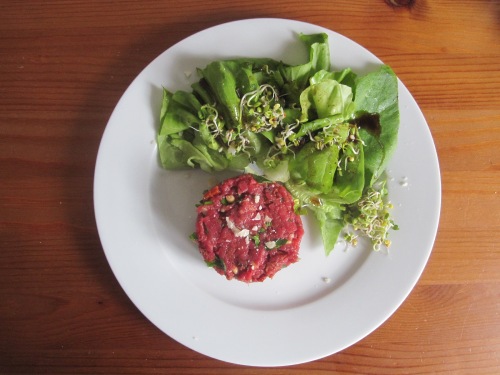
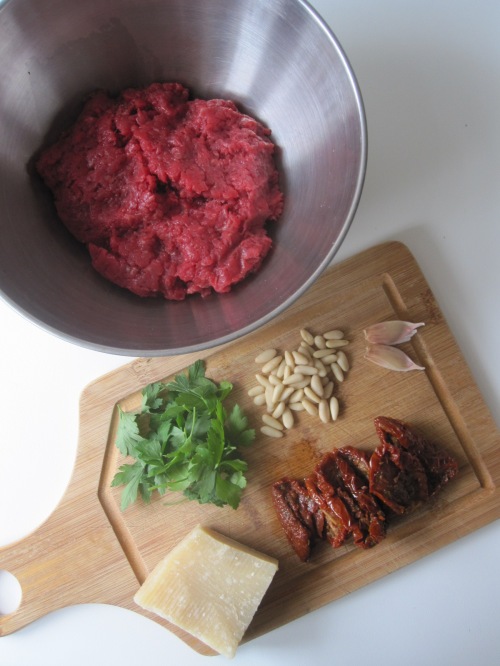
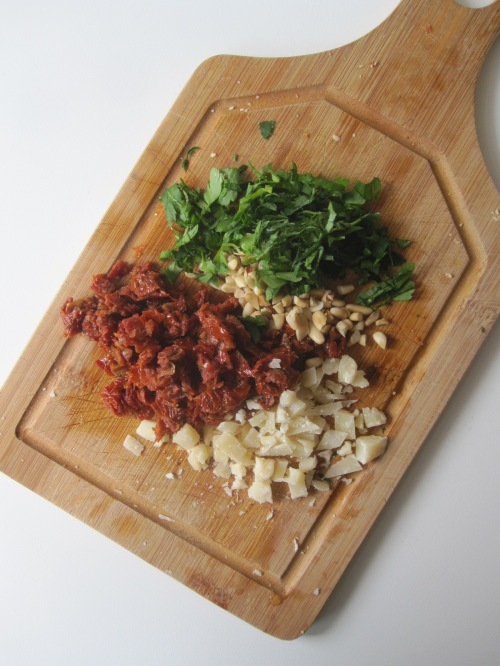
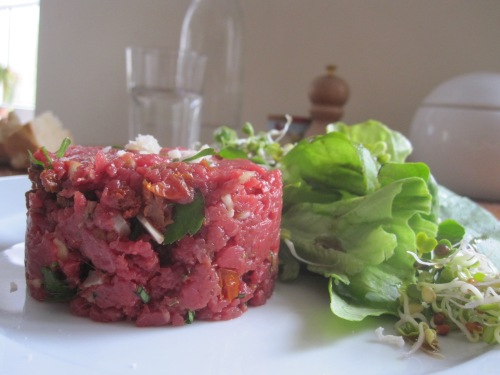
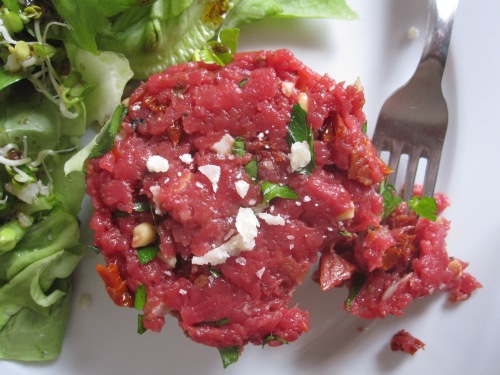
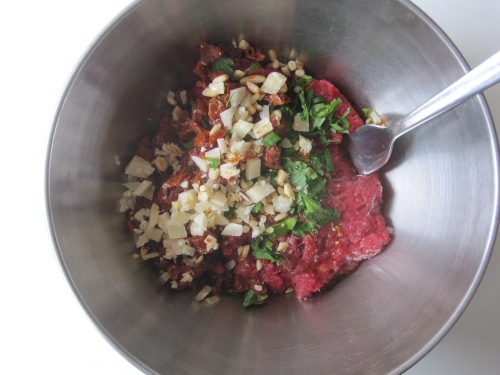
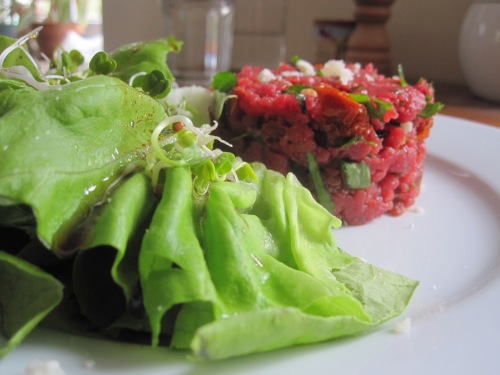
Never thought to ask about hand chopped meat for this. You bring up a very good point. Great recipe.
Have you been using ground meat? If you like raw tartare, I really think it is worth giving chopped meat a try! The texture is completely different!
Merci pour la citation ! Qu’as-tu fait à ton boucher pour qu’il accepte de te couper la viande au couteau ? A Paris, ils sont trop pressés ou c’est moi qui ne sait pas m’y prendre. Tu as raison de varier les assaisonnements, rien que de voir cette viande bien rouge, miammm !!!
Ah je dois avouer qu’on a de la chance avec ce boucher ; il prend le temps qu’il faut avec chaque client (au grand dam des clients qui font la queue à l’extérieur et qui savent qu’ils en ont pour 3 heures à attendre, mais nous sommes tous passés par là un jour ou l’autre 🙂 ) ; et c’est vrai que les gens du Ch’Nord sont généralement moins pressés qu’à Paris.
How wonderful. One of my forever favorites! Great touch with the pine nuts.
Yes, the pine nuts were a wonderful addition!
J’en veux!!!!
Bises et @+, Anne.
Darya, my dear, I love how you expose me to things I’ve never tried. I have totally heard of tartare but though I would consider myself adventurous in the food department, have, if I’m being totally honest, been a little scared to try 😉 Do I suspect correcttly that it’s a bit like the sushi but of the meat variety? I love me some good sushi and how fresh and clean it tastes … would a good tartare be similar, so you think?
xo
Christina, I must admit I only had my first tartare about two years ago. Before then, I was too scared to try. Now that I know a butcher I can trust (and a few restaurants in Paris which serve fantastic tartares), I really enjoy it ! The main difference with sushi is that sushi is sliced, whereas tartare is chopped quite finely, so the texture is quite different, eventhough they both have a « melt in the mouth » feeling. But a good tartare is both light and fresh, and at the same time quite decadent! If you are not afraid of sushi, you shouldn’t be afraid of raw meat! 🙂
Wonderful and so interesting! Thanks so much, Darya =) xo
A beautiful smart version!
Thank you, Fae!
I enjoy eating sashimi and carpaccio but irrationally I am reluctant to eat tartare beef. This inspires me to have a go….
I also used to be reluctant, but then I tried, and have loved a good tartare ever since! (A bad tartare can be awful, so I really must insist that you get the best possible meat).
Your butcher is making me consider a move to Paris! Tantalizing post!
Azita, I live in Lille, which is one hour North of Paris! This butcher is really special: he is the son of a butcher (who was the son of a butcher, who himself was the son of a butcher…), worked in the shop his entire life, all his brothers and sisters are butchers, all the « charcuterie » is home-made, people come from all over the region to go to his shop ! He is really quite unique (but there are excellent butchers in Paris too, of course). 🙂
Hmmm, there’s the storytelling yummy-food-making Darya and a storybook butcher … Revising plans to consider a move to Lille! 😉
This looks absolutely incredible. I love your take on food. Thank you!
Thank you for the kind words!
Ta viande a l’air fondante ! Je ne suis pas une grande fan du tartare de boeuf, mais il va bien bien falloir que je fasse plaisir chez moi un jour 🙂
Oui, la viande était vraiment fondante ! Avant de goûter mon premier tartare au couteau, je n’aimais pas beaucoup les tartares, mais maintenant j’adore ça ! (occasionnellement)
l’assaisonnement est très parfumé ,une merveille ce tartare !
Merci !
Wonderful, Darya! I love tartare and yours looks fantastic, so fresh!
Great job as usual.
Thank you, Stefano!
je suis aussi une grande fan de tartare mais je n’ai pour le moment pas osé en faire à la maison par peur de ne pas maîtriser l’assaisonnement. Si on n’a pas de pignons sous la mains, des cacahuètes non salées iraient ?
J’ai gouté un de mes meilleurs tartares dans un restaurant près de Poissonière (Les Saisons). Je rêve d’y retourner !
Je pense que des cacahuètes non salées ou des amandes feraient l’affaire. Il ne faut pas avoir peur de se lancer, les assaisonnements peuvent aisément s’improviser pour un tartare, mais il faut être sûr de la qualité de la viande !
Je ne connais pas Les Saisons, merci pour la recommandation ! A tester
That meat looks so fresh. Beautiful!
As you yourself said in your Tartare post, the key to a delicious tartare is the freshness of the meat! 🙂
J’aime bien le tritre de cet article et les couleurs du plat!
Merci !
Héhé, il fallait se douter que Tortore nous proposerait une recette de tartare… Mais j’ai beau apprécier son titre, je crains de ne pas la tester : c’est bizarre car bien qu’un bon steak bleu soit probablement une des choses dont je me délecte le plus, je ne suis pas du tout attirée par l’idée de manger du bœuf cru (de même que n’importe quelle autre viande)… Ça me semble moins dérangeant avec les produits de la mer.
L’idée du titre ne m’est venue qu’au moment de rédiger le billet. Pourtant, c’était une évidence ! Je comprends que tu ne sois pas attirée par la viande crue puisque j’ai longtemps été dans la même situation que toi ; je pense que c’est un « acquired taste », alors je ne peux rien dire qui puisse te convertir ! 🙂
Delicious Darya! I’ve of course tasted the traditional version but Italiano style looks equally tasty. It’s such a fresh and lovely take on a classic dish loved by all.
Thank you! I also love the traditional tartare, but this one is a nice change.
Le tartare de la tortore : c’était obligé de la faire 🙂 Sion je suis une grande fan des pignons et parmesan dans le tartare, donc j’approuve. Petite astuce maison : rajouter une mini pointe d’ail blanchi si on aime.
Une pointe d’ail (mini ou même maxi) est toujours la bienvenue ! 🙂
Aw yum! I ate tartare yesterday, and I love the fact that you’ve included sundried tomatoes, parmesan and pine nuts in this! Such a delicious change from the normal cornichons, horseradish etc. Lovely photography also, as always. Thanks Darya! Awesome post!! xx
Thank you ! 🙂
This looks absolutely delicious Darya! I love tartare, but you’re right – eating it at some restaurants is a bit like a game of Russian Roulette! I will definitely try making it at home now – thanks for the inspiration! Hope you’re doing well! xo
Thank you, Lindsay! For me a good tartare is a sign of a good restaurant, that cares about the actual produce they are serving. It is not so easy to come by! I’m doing great actually. I hope you and Matt are well too! 🙂
Coucou ♥
J’ai mis ta jolie recette directement dans les favoris ! J’adore ton assaisonnement et mon binôme a aussi craqué dessus !
Merci 🙂
Bonne journée douce et gourmande 🙂
Bisous doux ♥
ps : désolée, j’ai du retard dans mes visites ! ^^’
Merci ! Je suis ravie que cette recette te plaise (et pas surprise qu’elle ait plu à ton « binôme », les hommes et la viande… c’est une longue histoire d’amour non ?)
Bonne journée !
Merci !
voici le mien inspiré de ta recette (j’ai remplacé le persil par du basilic)
Super ta version, elle a l’air vraiment bonne, et le basilic c’est une excellente idée, je suis sûre que c’était parfait comme ça ! Merci pour la photo 🙂
http://instagram.com/p/cjIE4Dv5gk/
[…] c’est une vraie-fausse recette puisqu’elle est plus qu’inspirée que celle de Tortore. Je suis une grande fan de tartare, que ce soit de la viande, du poisson ou des légumes. […]
Je découvre ton blog, et je suis conquise!!! Que de belles recettes et de belles saveurs!! Sans parler de tes photos qui sont juste magnifiques! J’adore les tartares et celui-ci ne fait pas exception à la règle 🙂
Merci Patou ! C’est vraiment gentil à toi, je connais ton blog depuis un bout de temps (je l’ai découvert via Piment Oiseau), d’ailleurs j’ai bien envie de préparer tes beignets de cresson un de ces quatre. Le fesenjan que tu viens de partager est une de mes recettes préférées de tous les temps ! Une pure merveille.